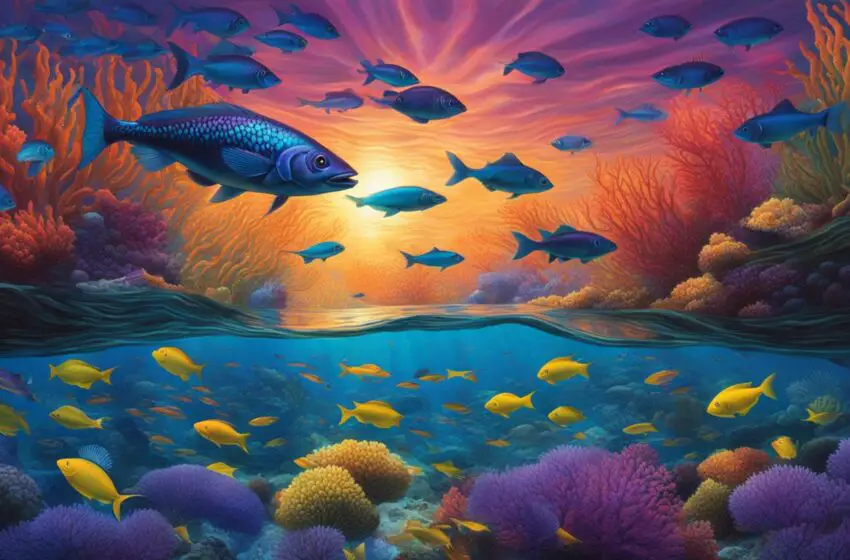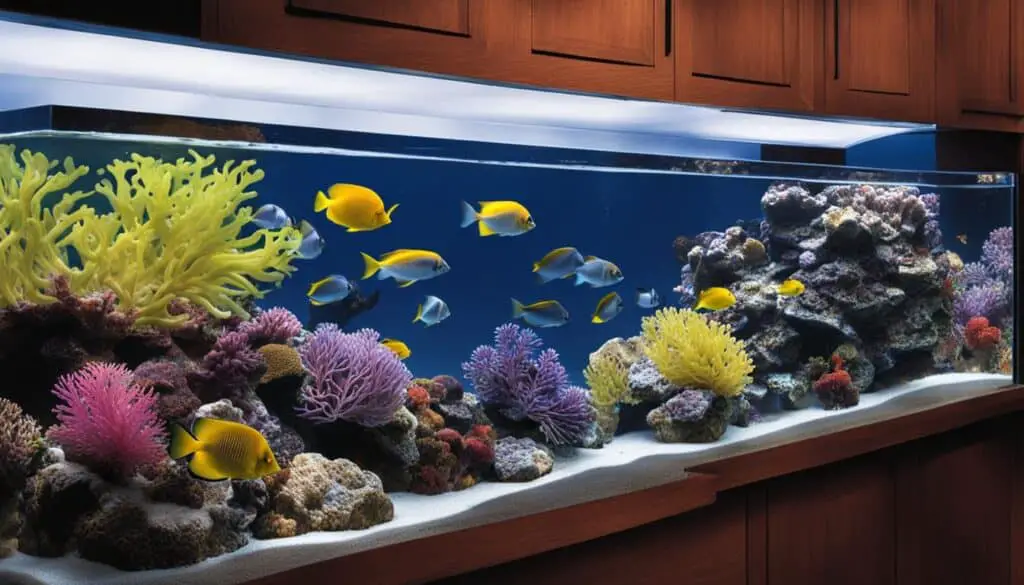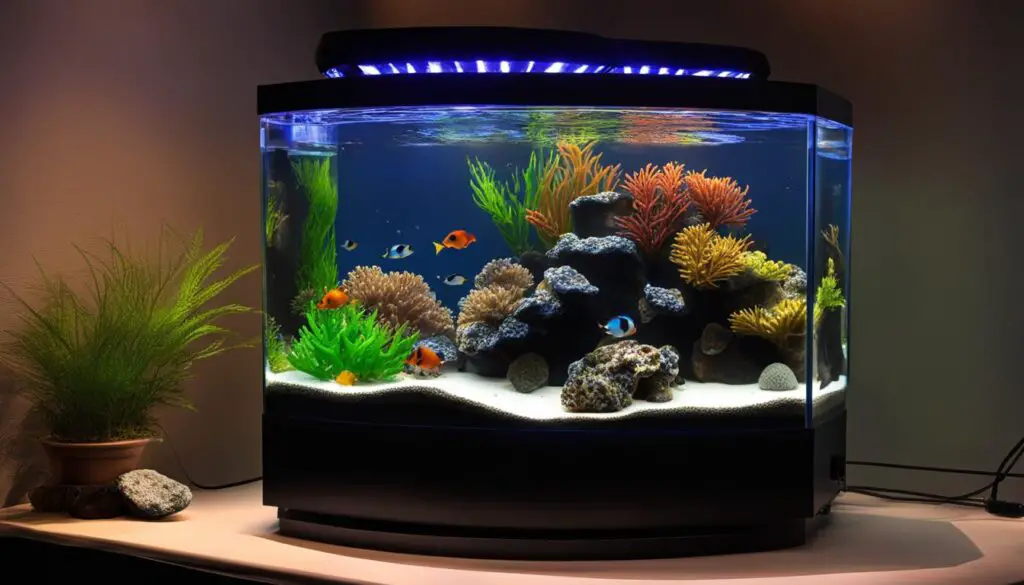Transitioning from Freshwater to Saltwater Aquarium Lighting

Converting a freshwater aquarium into a saltwater aquarium is a thrilling venture that allows you to dive into the mesmerizing world of marine life. Don’t worry, the process doesn’t have to be complicated or expensive. In fact, with a few adjustments and the equipment you already have, you can create a remarkable saltwater aquarium system.
In this section, I will guide you through the necessary equipment for a successful transition, including the crucial aspect of lighting. Whether you are a seasoned hobbyist or just starting out, understanding how to convert your aquarium lighting from freshwater to saltwater is essential for the health and vibrancy of your marine ecosystem.
Key Takeaways:
- Converting a freshwater aquarium to saltwater is an exciting and achievable endeavor.
- Utilize your existing equipment and make a few adjustments to create a fantastic saltwater aquarium system.
- The size of your tank and the type of substrate are important considerations for a successful transition.
- Saltwater aquariums require proper filtration and lighting to support the diverse marine life.
- Ensure that all equipment is rated for use in saltwater environments and consider replacing decorations with suitable options.
Aquarium Size and Substrate
When transitioning your aquarium from freshwater to saltwater, it is crucial to consider the size of your tank and the type of substrate you use. These factors play a significant role in creating a suitable environment for saltwater fish and other marine organisms.
Aquarium Size for Saltwater:
The size of your aquarium is an important consideration when making the switch to a saltwater setup. Generally, larger tanks are recommended for better water stability and to accommodate the specific needs of saltwater fish.
With a larger aquarium, you have more water volume, which allows for better dilution of waste and maintains stable water parameters. It also provides a more spacious environment for fish to swim and display their natural behavior.
Substrate for Saltwater Aquarium:
While gravel is commonly used as substrate in freshwater aquariums, saltwater tanks require a different type of substrate to support the diverse marine life that will inhabit the tank. In a saltwater setup, it is recommended to use either sand or crushed coral as the substrate.
Sand is a popular choice for saltwater aquariums due to its natural appearance and its ability to mimic the ocean floor. Sand allows for the burrowing behavior of certain fish species and provides a suitable habitat for various invertebrates.
Crushed coral, on the other hand, can help maintain the pH and alkalinity levels in the water, which is crucial for certain marine organisms. It also provides a substrate that encourages the growth of beneficial bacteria, contributing to the overall health of the aquarium.
| Aquarium Size | Recommended Substrate |
|---|---|
| 20-30 gallons | Sand |
| 30-55 gallons | Sand or crushed coral |
| 55+ gallons | Crushed coral |
Choosing the right aquarium size and substrate is crucial for the success of your saltwater aquarium. It ensures the well-being of your marine life and creates a visually appealing environment. Take into account the specific needs of your fish and other organisms when deciding on the size and substrate for your saltwater aquarium.
Filtration and Lighting
When it comes to saltwater aquariums, proper filtration and lighting are essential for maintaining the health and well-being of your marine organisms. Saltwater tanks require more advanced filtration systems compared to their freshwater counterparts due to the higher water quality needs of marine life.
To enhance your existing freshwater filtration system, consider adding another hang-on tank filter or upgrading to a canister filter. These additions will greatly improve the efficiency and effectiveness of your filtration, resulting in cleaner and clearer water for your saltwater aquarium.

Another important component of filtration in a saltwater aquarium is the use of live rock. Live rock acts as a natural biological filter, housing beneficial bacteria that help break down waste and maintain a stable nitrogen cycle. It also provides a habitat for various forms of marine life, contributing to the overall biodiversity of your tank.
Now let’s shift our focus to lighting. In fish-only saltwater tanks, standard fluorescent bulbs are sufficient to illuminate the tank and showcase your beautiful marine fish. However, if you plan to keep corals or other light-dependent invertebrates, upgrading to high-quality lighting options such as LED lights is crucial.
LED lights offer several advantages, including energy efficiency, longevity, and the ability to customize the light spectrum to meet the specific needs of your corals. With LED lighting, you can create dynamic lighting effects and simulate natural daylight conditions, promoting the growth and vitality of your coral reef.
Benefits of Upgrading to LED Lighting:
- Enhanced color rendition: LED lights produce a full spectrum of colors, enhancing the vibrant colors of your coral and fish.
- Energy efficiency: LED lights consume less energy compared to traditional lighting options, resulting in lower electricity bills.
- Longer lifespan: LED lights have a much longer lifespan compared to fluorescent bulbs, reducing the need for frequent replacements.
- Heat reduction: LED lights generate minimal heat, preventing temperature fluctuations and potential harm to delicate marine organisms.
- Customizable settings: LED lights offer adjustable settings, allowing you to control the intensity, color, and duration of lighting periods to create optimal conditions for your aquarium.
With the right filtration system and lighting setup, you can create a thriving saltwater aquarium that provides a conducive environment for the growth and well-being of your marine inhabitants.
Equipment Considerations
When transitioning from a freshwater to a saltwater aquarium, it’s important to consider the equipment you’ll need to ensure a successful conversion. While most of the equipment used in freshwater aquariums is compatible with saltwater setups, there are a few key considerations to keep in mind.
Heater for Saltwater Aquarium:
A crucial piece of equipment for a saltwater aquarium is a reliable heater. Saltwater fish and marine organisms require a stable temperature range to thrive. Look for a heater that is specifically designed for use in saltwater environments to ensure optimal performance and longevity.
Decor for Saltwater Aquarium:
Another important aspect of setting up a saltwater aquarium is choosing the right decorations. While plastic plants may be suitable for freshwater tanks, they are not recommended for saltwater aquariums. Instead, opt for live rock or appropriate synthetic options to create a natural and visually appealing environment for your saltwater creatures.
Researching and selecting the right equipment for your specific needs is essential to create a successful saltwater aquarium. Ensure that all equipment, including heaters and filters, is rated for use in saltwater environments to avoid any compatibility issues. By investing in the right equipment and providing a comfortable habitat for your marine inhabitants, you’ll be well on your way to enjoying the beauty of a thriving saltwater aquarium.

| Equipment | Recommended for Saltwater Aquariums |
|---|---|
| Heater | Specifically designed for saltwater environments |
| Decorations | Live rock or appropriate synthetic options |
Conclusion
Converting a freshwater aquarium to a saltwater system can be an exciting and rewarding experience. It opens up a whole new world of marine life and allows you to explore the beauty of saltwater ecosystems right in your own home.
By utilizing your existing equipment and making the necessary adjustments, you can create a thriving saltwater aquarium without breaking the bank. Consider the size of your tank and ensure it is suitable for housing the diverse marine species you wish to keep. Research and invest in the appropriate substrate, such as sand or crushed coral, to provide a natural environment for your marine inhabitants.
Filtration is a crucial aspect when transitioning from freshwater to saltwater; upgrading your filtration system or adding additional filters can help maintain the higher water quality necessary for marine organisms. Lighting is another essential factor to consider, especially if you plan to keep corals or other light-dependent invertebrates. Upgrading to high-quality LED options will ensure the optimal light spectrum for their growth and well-being.
Finally, don’t forget to research and invest in the right equipment for your saltwater aquarium, ensuring that everything is rated for saltwater use. Consider replacing any incompatible decorations, such as plastic plants, with live rock or synthetic options that are suitable for saltwater environments.
With proper research, preparation, and attention to detail, you can successfully convert your freshwater aquarium into a thriving saltwater system. Embrace the challenge, unleash your creativity, and enjoy the beauty and diversity of marine life in your very own saltwater aquarium.
FAQ
What kind of lighting do I need for a saltwater aquarium?
For fish-only saltwater tanks, standard fluorescent bulbs will suffice. However, if you plan to keep corals or other invertebrates, you will need to upgrade to high-quality lighting, such as LED options.
What size aquarium is recommended for a saltwater setup?
Generally, larger aquariums are recommended for better water stability and to accommodate the specific needs of saltwater fish.
Can I use gravel as a substrate in a saltwater aquarium?
No, saltwater tanks require sand or crushed coral as a substrate to support the diverse marine life that will occupy the tank.
How does filtration differ in saltwater aquariums compared to freshwater tanks?
Saltwater aquariums require more filtration than freshwater tanks due to the higher water quality needs of marine organisms. Adding another hang-on tank filter or upgrading to a canister filter can enhance your freshwater filtration system.
Can I use the same equipment from my freshwater aquarium in a saltwater setup?
Most equipment used in freshwater aquariums is compatible with saltwater setups. However, it is important to ensure that all equipment, including heaters and filters, is rated for use in saltwater environments.



